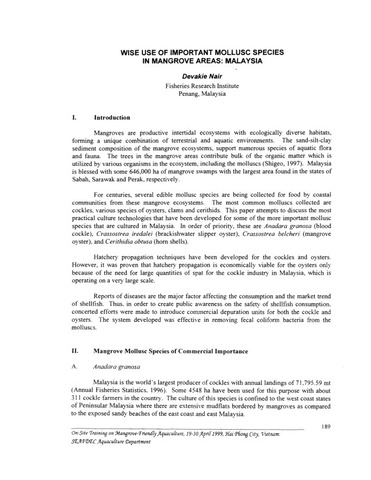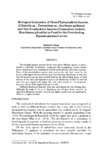Early development of Crassostrea iredalei (Faustino, 1932) (Bivalvia: Ostreidae), with notes on the structure of the larval hinge
| dc.contributor.author | Ver, Leo Michael M. | |
| dc.date.accessioned | 2012-11-06T06:10:02Z | |
| dc.date.available | 2012-11-06T06:10:02Z | |
| dc.date.issued | 1986 | |
| dc.identifier.citation | Ver, L. M. M. (1986). Early development of Crassostrea iredalei (Faustino, 1932) (Bivalvia: Ostreidae), with notes on the structure of the larval hinge. Veliger, 29(1), 78-85. | en |
| dc.identifier.issn | 0042-3211 | |
| dc.identifier.uri | http://hdl.handle.net/10862/1201 | |
| dc.description | SEAFDEC Aquaculture Department Contribution No. 158. | en |
| dc.description.abstract | Larvae of the oyster Crassostrea iredalei were reared in the laboratory from eggs through settlement. The oysters were induced to spawn by increasing the temperature by 5-10°C and sometimes by adding stripped oyster sperm to the spawning dishes. Eggs avareaged 48 µm in diameter. The straight-hinge veligers appeared 22 to 26 h after fertilization. The larval shell length increased from 64 to 84 µm in the straight-hinge stage, from 85 to 275 µm in the umbo stage, and from 210 to 275 µm in the pediveliger stage. Eye-spotted pediveligers were observed mostly at lengths greater than 225 µm. The hinge line did not increase much with larval growth. Although length was initially greater than height, the increase in height was much faster due to the development of the umbo. Height was greater than length in more advanced larvae. Valve growth was asymmetrical and unequal, with the left valve generally larger. Settlement and metamorphosis occurred 20 days from fertilization at lengths of 270 µm and greater, when the oyster larvae were reared at 26.5 to 30°C and salinities of 30 to 32 ppt. The larval hinge structure consisted of minute dentition on the central portion of the provinculum and large rectangular teeth on both ends. These teeth became obscured in advanced larvae due to the skewed development of the umbo. Data derived from the laboratory culture of larvae of Crassostrea iredalei may be used in spatfall forecasts for the collection of larvae from the wild and as baseline information for the hatchery culture of oyster larvae. | en |
| dc.language.iso | en | en |
| dc.publisher | California Malacozoological Society, Inc. | en |
| dc.subject | Crassostrea iredalei | en |
| dc.title | Early development of Crassostrea iredalei (Faustino, 1932) (Bivalvia: Ostreidae), with notes on the structure of the larval hinge | en |
| dc.type | Article | en |
| dc.citation.volume | 29 | |
| dc.citation.issue | 1 | |
| dc.citation.spage | 78 | |
| dc.citation.epage | 85 | |
| dc.citation.journalTitle | Veliger | en |
| dc.subject.asfa | oysters | en |
| dc.subject.asfa | aquatic molluscs | en |
| dc.subject.asfa | animal morphology | en |
| dc.subject.asfa | developmental stages | en |
| dc.subject.asfa | larval stage | en |
| dc.subject.scientificName | Crassostrea iredalei | en |
| dc.subject.scientificName | Magallana bilineata | en |
このアイテムのファイル
| ファイル | サイズ | フォーマット | 閲覧 |
|---|---|---|---|
|
このアイテムに関連するファイルは存在しません。 |
|||
このアイテムは次のコレクションに所属しています
-
Journal Articles [1256]
These papers were contributed by Department staff to various national and international journals.



